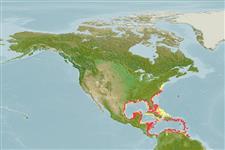>
Syngnathiformes (Pipefishes and seahorses) >
Syngnathidae (Pipefishes and seahorses) > Syngnathinae
Etymology: Syngnathus: Greek, syn, symphysis = grown together + Greek, gnathos = jaw (Ref. 45335).
More on authors: Jordan & Gilbert.
Environment: milieu / climate zone / depth range / distribution range
Οικολογία
Θαλασσινό(ά) βενθικό(ς); εύρος βάθους 18 - 55 m (Ref. 126547), usually ? - 5 m (Ref. 126547). Subtropical; 40°N - 8°N
Western Atlantic: disjunct distribution from Bermuda and Chesapeake Bay (USA), including the northern Gulf of Mexico, the Bahamas, and the western Caribbean Sea (Ref. 37039), to Panama.
Μέγεθος / Βάρος / Age
Maturity: Lm ? range ? - ? cm
Max length : 26.0 cm TL αρσενικό/απροσδιόριστο; (Ref. 27549)
Short description
Κλείδες προσδιορισμού | Μορφολογία | Μορφομετρία
Μαλακές ραχιαίες ακτίνες (συνολικά) : 26 - 35. Preorbital bone appears as broad plate in front of eye (Ref. 26938).
Abundant in seagrass beds along coasts. Northern populations move offshore during colder months (Ref. 26938). Found mostly at 5 m or less (Ref. 126547). Ovoviviparous (Ref. 205). The male carries the eggs in a brood pouch which is found under the tail (Ref. 205). Feeds mostly on small grass shrimp and other small crustaceans (Ref. 93252).
Life cycle and mating behavior
Maturities | Αναπαραγωγή | Spawnings | Egg(s) | Fecundities | Προνύμφες
Male carries the eggs in a brood pouch (Ref. 205, 53335).
Robins, C.R. and G.C. Ray, 1986. A field guide to Atlantic coast fishes of North America. Houghton Mifflin Company, Boston, U.S.A. 354 p. (Ref. 7251)
IUCN Red List Status (Ref. 130435)
Threat to humans
Harmless
Human uses
Εργαλεία
Special reports
Download XML
Διαδικτυακές πηγές
Estimates based on models
Preferred temperature (Ref.
123201): 23.5 - 28.2, mean 27.1 °C (based on 614 cells).
Phylogenetic diversity index (Ref.
82804): PD
50 = 0.5000 [Uniqueness, from 0.5 = low to 2.0 = high].
Bayesian length-weight: a=0.00028 (0.00012 - 0.00065), b=3.21 (3.03 - 3.39), in cm total length, based on LWR estimates for this Genus-body shape (Ref.
93245).
Τροφικό Επίπεδο (Ref.
69278): 3.3 ±0.45 se; based on food items.
Ελαστικότητα (Ref.
120179): Υψηλό, ελάχιστος χρόνος για διπλασιασμό πληθυσμού < 15 μήνες (Preliminary K or Fecundity.).
Fishing Vulnerability (Ref.
59153): Low vulnerability (16 of 100).
